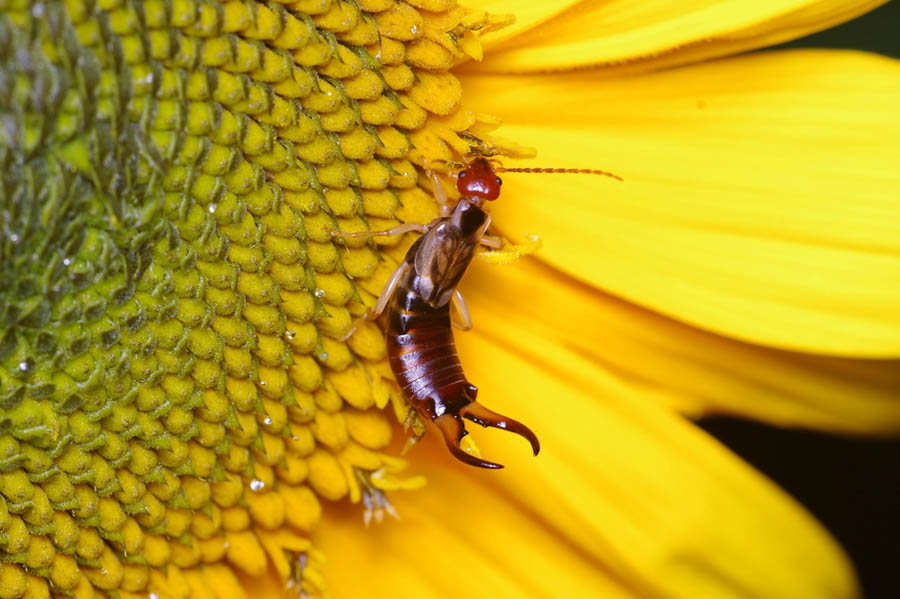Down and Dirty 11: Nontoxic Habitat Traps for Earwigs

Down and Dirty Southern California Gardening
A weekly GardenZeus article series to help gardeners succeed in Southern California’s unique climates and growing conditions.
Post 11: Nontoxic Habitat Traps for Earwigs
Did you know? Earwig pincher appendages at their rear-ends are more curved in male earwigs, and more straight in female earwigs.
European earwigs provide an uncertain combination of beneficial insect and pest in the California garden. They eat aphids and mites, but also seedlings, new plant growth, flowers, and soft plant matter of all sorts. See Down and Dirty 10: Earwigs Are Fickle Allies in the Garden for an introduction to earwigs in the California garden.
Earwigs can be devastating to plant foliage, berries, soft fruits such as many stone fruits, and other soft plant matter when they reach infestation levels in gardens, landscapes, and orchards. They eat the silks of sweet corn, which results in poor pollination and corn cobs with missing kernels or even scattered-to-no kernels.
The damage caused by earwigs may look similar to that caused by other chewing insects. Small holes left by earwigs in berries such as strawberries may appear similar to damage caused by slugs and snails, but earwigs don’t leave slime trails and they don’t leave the visible masses or lumps of frass (poop) typical of snails, or the small pellets of frass that are typical of slugs. Earwigs tend to chew small holes in leaves or chew along edges of leaves. They may chew favorite or delicious seedling varieties down to stubs, and in severe infestations or when food sources are limited they may skeletonize leaves as is more typical of feeding by caterpillars and moth larvae.
This leaf damage may have been caused by earwigs.
You may catch earwigs munching on your plants during the day, but generally they are more active at night. To confirm that chewing damage is caused by earwigs, you may have to take an expedition out into your garden at night with a flashlight to inspect the plants that are being damaged. Earwigs aren’t shy when they’re hungry, and with the exception of burrowing into fruits, berries, or occasionally soft vegetables, they aren’t hard to find or see when they’re taking a meal. If you can’t find them after a few attempts, they’re probably not the culprit.
Earwigs love water. They don’t survive or reproduce well in natural areas within Southern California’s dry Mediterranean climate or in dry, non-irrigated urban areas and gardens, and they tend to be more scarce and less problematic in hot-summer areas once persistent hot weather sets in. They prefer cool temperatures and moist habitat, and are particularly problematic in coastal and costal-influence irrigated gardens in California.
Almost anywhere that is moist and shaded can provide earwig habitat including dense garden plantings; weed patches; moist areas under pots, containers, rocks, and boards; inside edges of raised beds or pots; in or under fallen fruit; within and under living groundover such as ivy; and in almost any form of mulch especially a thick layer of mulch that remains perpetually moist at or above soil level.
If you have an earwig problem, this may simply be the result of ample habitat and moisture in your garden or landscape. You may also be overwatering. Clear or minimize habitat areas and and allow soil surface to dry before watering again.
Most home-garden earwig infestations can be eliminated within days to a week or two with homemade traps. Use cardboard tubes from empty rolls of paper towels or similar, block up one end, put a shallow layer of moist compost or decomposed organic matter into the tube, and half-bury the tube(s) or place them in shaded areas, on soil, or under mulch near affected plants. Other tubes can also work, such as cut-up sections of garden hose, bamboo tubes, or even empty narrow glass candle jars or other narrow glass or plastic jars. Cover each trap with a thin wooden board, cardboard, or similar to keep the traps shaded and moist. This creates ideal earwig habitat (with air, moisture, a degree of darkness, and organic matter).
Set out multiple homemade traps in the afternoon or evening every day and gather them the next morning or during the day. After a few rounds of manual trapping, your earwig problem should be greatly reduced or eliminated. Feed the earwigs to chickens if available. I personally don’t like killing, so I would make an effort to relocate the insects to somewhere that they would not cause harm. Many gardeners dispose of earwigs by drowning them in soapy water or emptying them into plastic bags and manually crushing them.
“Down and Dirty Southern California Gardening” is a weekly GardenZeus article series in which expert Darren Butler shares more than 20 years of experience about what works and what doesn’t with gardening in Southern California:
Post 10: Earwigs Are Fickle Allies in the Garden
Post 12: Summer and “Summerer” (Summerer Part 1)
All articles in this series: Down and Dirty Southern California Gardening
GardenZeus Calfornia climate zones
Enter your California zip code for customized advice by plant
